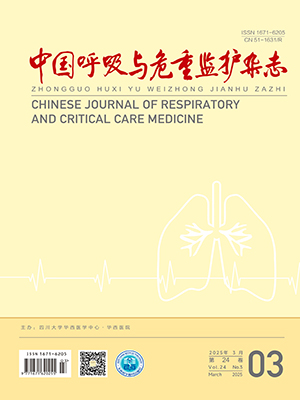| 1. |
Diehl JL, El Atrous S, Touchard D, et al. Changes in the work of breathing induced by tracheotomy in ventilator-dependent patients. Am J Respir Crit Care Med, 1999, 159(2): 383-388.
|
| 2. |
Rumbak MJ, Newton M, Truncale T, et al. A prospective, randomized, study comparing early percutaneous dilational tracheotomy to prolonged translaryngeal intubation in critically ill medical patients. Crit Care Med, 2004, 32(8): 1689-1694.
|
| 3. |
Nieszkowska A, Combes A, Luyt CE, et al. Impact of tracheotomy on sedative administration, sedation level, and comfort of mechanically ventilated intensive care unit patients. Crit Care Med, 2005, 33(11): 2527-2533.
|
| 4. |
梁天佳, 莫明玉, 周开斌, 等. 气道廓清术在脑卒中相关性肺炎气管切开患者康复中的应用. 中国呼吸与危重监护杂志, 2021, 20(4): 270-273.
|
| 5. |
Terragni PP, Antonelli M, Fumagalli R, et al. Early vs late tracheotomy for prevention of pneumonia in mechanically ventilated adult ICU patients: a randomized controlled trial. JAMA, 2010, 303: 1483-1489.
|
| 6. |
Pelosi P, Ferguson ND, Frutos-Vivar F, et al. Management and outcome of mechanically ventilated neurologic patients. Crit Care Med, 2011, 39: 1482-1492.
|
| 7. |
Seder DB. Tracheostomy practices in neurocritical care. Neurocrit Care, 2019, 30: 555-556.
|
| 8. |
Corley A, Caruana LR, Barnett AG, et al. Oxygen delivery through high-flow nasal cannulae increase end-expiratory lung volume and reduce respiratory rate in post-cardiac surgical patients. Br J Anaesth, 2011, 107(6): 998-1004.
|
| 9. |
Groves N, Tobin A. High flow nasal oxygen generates positive airway pressure in adult volunteers. Aust Crit Care, 2007, 20(4): 126-131.
|
| 10. |
Cuquemelle E, Pham T, Papon JF, et al. Heated and humidified highflow oxygen therapy reduces discomfort during hypoxemic respiratory failure. Respir Care, 2012, 57(10): 1571-1577.
|
| 11. |
Moller W, Celik G, Feng S, et al. Nasal high flow clears anatomical dead space in upper airway models. J Appl Physiol, 2015, 118(12): 1525-1532.
|
| 12. |
中华医学会呼吸病学分会呼吸危重症医学学组, 中国医师协会呼吸医师分会危重症医学工作委员会. 成人经鼻高流量湿化氧疗临床规范应用专家共识. 中华结核和呼吸杂志, 2019, 42(2): 83-91.
|
| 13. |
MacIntyre NR, Cook DJ, Ely EW, et al. Evidence-based guidelines for weaning and discontinuing ventilator support: a collective task force facilitated by the American College of Chest Physicians, the American Association for Respiratory Care, and the American College of Critical Care Medicine. Chest, 2001, 120: 375S-395S.
|
| 14. |
郭芸, 张燕华, 汪海燕. 气管切开停机患者主动湿化与被动湿化效果分析. 内科, 2016, 11(3): 436-438.
|
| 15. |
贺丽琼, 逯学梅, 安颖, 等. 高流量装置联合湿化器对昏迷患者气道湿化的效果研究. 中国现代医生, 2016, 54(15): 69-71.
|
| 16. |
杜全胜, 杨圣俊, 周汝明, 等. 新型气道湿化系统对气管切开患者医院获得性肺炎的影响. 临床合理用药杂志, 2013, 6(031): 131-132.
|
| 17. |
郭润玲, 王颖, 王耀勇, 等. 高流量联合MR850在气管切开患者停机状态下的应用研究. 中华危重病急救医学, 2018, 30(10): 943-945.
|
| 18. |
丁翠翠. 高流量温湿化氧疗在气管切开患者中的应用. 大家健康(上旬版), 2017, 11(5): 112.
|





 Baidu Scholar
Baidu Scholar